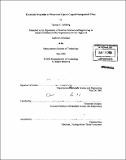Electronic properties of phenylated ligand-capped nanoparticle films
Author(s)
Özden-Schilling, Thomas Charles.
DownloadFull printable version (1.686Mb)
Other Contributors
Massachusetts Institute of Technology. Dept. of Materials Science and Engineering.
Advisor
Francesco Stellacci.
Terms of use
Metadata
Show full item recordAbstract
An investigation was carried out of the electronic characteristics of drop-cast films comprised of phenylated ligand-capped gold nanoparticles. In homoligand-type films, the dominant mechanism of charge transfer was expected to involve orbital overlap and end group-effected wave function displacement, whereas heteroligand-type films were expected to conduct through less efficient hopping mechanisms. Films utilizing the former mechanism are expected to have great applicability within microelectronics and rapid-prototyping technologies due to the small scale (2-6nm) of functionalized nanoparticles and the structural flexibility of interdigitation as a form of inter-particle bonding. The comparative conductances of the cast films reveal a strong correlation with the ligand Hammaker constant (effectively a measure of the work function of the conjugated bond with the gold core of the nanoparticle and the charge displacement effected by the electronegativity or polarity of the ligand end group). The conductance was also greatly affected by the size of ligand end groups - a rough measure of the close-packing ability of a given ligand both within the ligand shell and amongst the shells of adjacent nanoparticles. The following experiments illustrate these correlations, as well as the effects of ligand spacing and shell composition on the dominant charge transfer mechanism.
Description
Thesis (S.B.)--Massachusetts Institute of Technology, Dept. of Materials Science and Engineering, 2006. Includes bibliographical references (leaves 35-37).
Date issued
2006Department
Massachusetts Institute of Technology. Department of Materials Science and EngineeringPublisher
Massachusetts Institute of Technology
Keywords
Materials Science and Engineering.